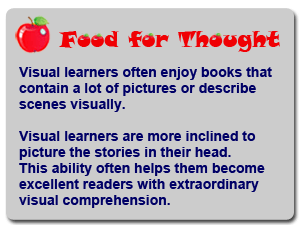Visualization
Good readers take the words they are reading and create pictures in their mind. This is known as visualization. Students who are good at visualization picture what the author has written and add detail that is not in the story. Some students can do this naturally, while others need guidance. Visualization is a hard skill to instruct because it relies on the readers imagination rather than just reading words.
Young children enjoy books that contain pictures, graphics, and illustrations. These images provide context clues that help the students comprehend the story. These books are also a good way to introduce children to the concept of visualization.
To teach visualization skills to beginning readers, you should have them read stories, and point out objects and actions in the illustration that are described in the text. As the students become comfortable with this, you can introduce some predictions strategies, and ask them what they think the illustration on the next page will look like.

As students move on to more complex texts, you should help them to apply their visualization skills to descriptions where there is no corresponding illustration. Ask the students to describe what they picture in their heads as they read a description of a visual scene. Have the students compare what they “see” and comment on the similarities and the differences. “Sally sees a blue house and Timmy sees a red one. The story does not actually tell us what color the house is. So you are both correct!”
Another strategy to help students with visualization is to have them draw scenes from the beginning, middle, and end of the story. Drawing the characters at critical points in a story requires them to stop and visualize the scenes in detail. By comparing the drawings, you can see how well the individual students visually comprehend the elements in the story. You can carry this exercise further by creating a graphic organizer where students plot the story's key elements.
Visualization allows students to think about the story in a different way and introduces them to the concept that words are not just about sound; they can also be about sight. Seeing what the characters see creates a whole new level of comprehension for the reader. The vicarious experience of seeing the characters point of view enables the reader to reach the next level of comprehension, which is to feel what the characters feel.
